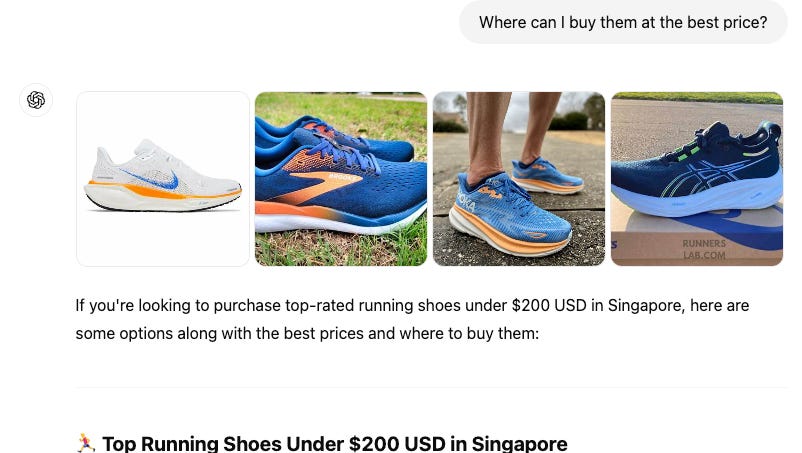
Lee Chong Ming/Business Insider
OpenAI is jumping into the online shopping game.
The company said on Monday it rolled out a new shopping feature for ChatGPT. Users can ask for product recommendations and receive results with images, reviews, and direct links.
ChatGPT will provide a curated list of products based on what it remembers about users’ preferences and what it pulls from online reviews, said Adam Fry, who leads ChatGPT’s search product team, in a prelaunch demo for Wired. Users are then sent to the retailer’s site to check out.
The feature works across categories like fashion, electronics, and home goods.
Unlike Google Shopping’s sponsored links, the product listings shown in ChatGPT are not paid placements, Fry said.
I tried out the new shopping feature to see if it could make shopping smarter and easier. It was helpful, but I missed a few parts of non-AI online shopping.
Getting ChatGPT’s techy recommendation
As an audiophile, I love a good pair of headphones.
I asked ChatGPT, “What are the best headphones under $500 USD?”
The response was impressive — and a bit overwhelming. It broke down options into categories like best wireless noise-canceling headphones, best audiophile and studio headphones, and budget-friendly picks.
It even gave me a handy “Top Picks Summary,” which helped cut through the clutter. The Sony WH-1000XM5 clinched the “Best Overall” — a model I’d heard people rave about.
But ChatGPT didn’t list where I could buy them, so I followed up with, “Where can I buy them at the best price?”
This time, ChatGPT served up live prices and retailer links in Singapore, where I live.
ChatGPT also suggested a rival to the Sony XM5 — the Bose QuietComfort Ultra.
I wanted to compare both in detail, so I asked: “What’s the difference between the Sony WH-1000XM5 and the Bose QuietComfort Ultra?”
ChatGPT came back with a side-by-side comparison that felt lifted from a high-end tech blog, covering everything from noise cancellation to fast-charging stats.
One gripe, though: I had no idea where the information came from. It said Bose had “plush cushioning and lighter clamp force,” while Sony offered “synthetic leather” and a lighter build. Those were objective details, but who decided Bose was more comfortable? What if I actually like the snug fit of Sony’s headband?
Buying a really personal item: running shoes
Next, I put ChatGPT to the test with running shoes. For me, this was make-or-break.
I’m obsessed with running shoes. I’ve gone too deep into the rabbit hole of reading shoe reviews, binge-watching YouTube breakdowns, and analyzing specs like a full-time job.
I told ChatGPT I was looking for shoes for easy, short-distance runs under $200.
My search yielded a solid list: Nike Air Zoom Pegasus 41, Brooks Ghost 16, Hoka Clifton 9, ASICS Gel-Nimbus 26, and New Balance Fresh Foam X 1080v14.
All great picks, but I was a little disappointed that my favourites, like the Adidas Ultraboost, didn’t show up.
When I refined my search and mentioned that I was a neutral pronator — my foot rolls naturally to absorb shock evenly — ChatGPT stuck to the same lineup with short, summarized notes about each shoe’s strengths.
I asked ChatGPT to break down the differences between the Brooks Ghost 16 and Hoka Clifton 9 since they were “Best Overall” and “Best Cushioning.”
The side-by-side comparison covered everything from cushioning and stability to ride feel.
But one big thing was missing: visuals.
As someone who cares a lot about how my shoes look — the sole design, the lacing, the vibe — I missed scrutinizing images beyond the four at the top.
I don’t blame ChatGPT for giving me a wordy review. But for something as personal as running shoes, I’d still rather scroll through a store’s website and rummage through every photo and video.
Google vs ChatGPT
Google’s shopping experience still feels a lot more fun. Although there are paid ads, there are also endless visuals — different colorways, angles, and even photos from real buyers showing off their pairs in the wild.
Plus, I love seeing user reviews. They’re raw, relatable, and sometimes way more helpful than expert reviews.
ChatGPT wins in the heavy-lifting department. It provides detailed comparisons and spec breakdowns without making you dig through 10 different websites.
It feels like an extension of what ChatGPT already does best — gathering info and summarizing it neatly. An AI built solely for shopping — or OpenAI’s next version of this feature — might provide a better experience.
I’m still an old-school shopper. I gather all possible sneaker info online, then head to the store to do a few laps.
No review can tell me the best — for me — pair until it’s on my feet.
The post I tried ChatGPT’s new shopping feature. It’s efficient, just not built for picky shoppers like me. appeared first on Business Insider.




